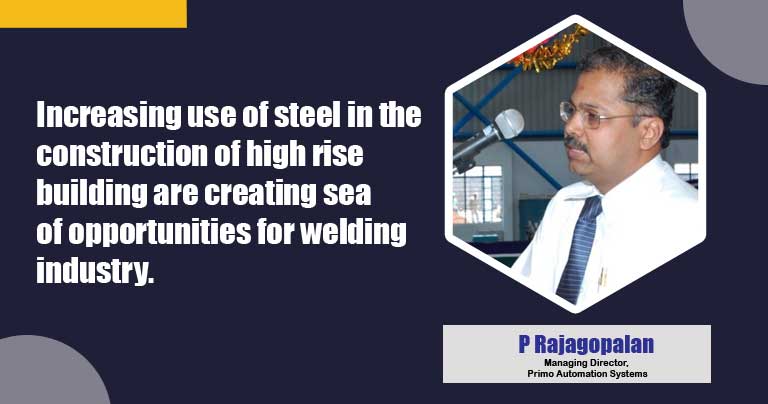PEB and infrastructure sectors impact welding industry at large
By Edit Team | October 30, 2021 7:55 pm SHARE

“Increasing use of steel in the construction of high rise building are creating sea of opportunities for welding industry,” says P Rajagopalan Managing Director, Primo Automation Systems.
How are the present industrial trends impacting growth in the welding sector?
Due to the emphasis on green energy from renewable sources, the segments such as solar and wind energy are growings, and contributes significantly to the growth of the welding sector. A shift has begun in the automotive sector to migrate towards environment friendly EVs. The need to produce a huge quantity of EVs will have a positive growth in the welding sector in coming years.
The expansion of railways and highways have a very positive impact on the growth of welding sector for structural fabrication for roads and rail bridges.
The trend to shift towards steel buildings from the conventional civil structures continues to be on the rise, and Further boosting the growth of fabricated weldings for primary structures in the PEB segment.
With increase in urbanisation and industrialisation, what kind of opportunities do you foresee in the welding sector?
One of the current trends is increasing use of steel in construction of high rise building which has been the exclusive domain of civil structures. There are many advantages of steel building, such as, parallel processing of structural members of all floors from day one, significant reduction in lead time, maximising industrial shop-floor fabrication with modern automated structural cutting, drilling, assembly, and welding systems leading to minimal on site activities. Recent example of many large covid care hospitals built in record number of days in many countries including India is direct pointer to similar benefits in urbanisation too.
How is Automation, AI and robotics helping you attain maximum precision while maintain efficiency of your products and their operations?
Automation (which is our core business) is no more a matter of choice. It has become essential to maintain quality, productivity and their consistency. With the addition of AI & Robotics, our customers are able to produce more with less skilled work force.
With government’s aim to increase domestic manufacturing and have more localisation, what are the present challenges in adopting the same?
The government’s push for localisation is directly and positively impacting the growth of domestic manufacturing. However, localisation in areas like defense have technology oriented challenges in multiple engineering disciplines such as electronics, polymer and rubber, metallurgy, etc., which needs to be addressed.
What kind of policy/regulations/investments support is required for the market revival?
The private industries are facing a low due to pandemic caused reasons such as restriction on international travel, disturbances in the supply chain and reduced demand in the international market. The government should come up with a ground breaking approach to mitigate the suffering of the industry for its revival.
The approach could be:
- Availability of Funds at a lower interest
- Deferred payments towards taxes for a longer period
- Permit increased repayment period for the loans already taken
- Bring in policies/guidelines that would accord ‘essential goods status’ to steel raw materials to avoid the fluctuationsin their availability and pricing for the domestic sector
How do you assess the growth prospects for the next 5 years in the infrastructure and construction equipment market?
As mentioned above, the current focus of the government in areas such as Railways (Modernisation, High speed trains, Bullet trains, dedicated freight corridors) and Highways for fueling the growth of infrastructure, which in turn positively impact the growth of the construction equipment market. The outlook for the next 5 years is very positive.
Cookie Consent
We use cookies to personalize your experience. By continuing to visit this website you agree to our Terms & Conditions, Privacy Policy and Cookie Policy.




































-20240213125207.png)

























